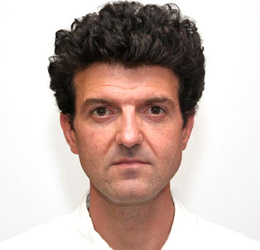Investigadores UMI
Myriam Benisty - Researcher
|
Ph.D. en Astrofísica, 2007, U. Grenoble-Alpes, Francia. Línea de Investigación: Protoplanetary Disks and Planet Formation Teléfono: 56 (2) 2 977 1137 E-mail: myriam.benisty@univ-grenoble-alpes.fr |
 |
Áreas de Interes My research focuses on the understanding of the structure, physics, and evolution of circumstellar disks. Also called protoplanetary disks, they are the birthplace of planets that are built from the disk material and in turn shape the structure of the disk. Using the Very Large Telescope Interferometer, I study the morphology of the innermost regions of protoplanetary disks within the first astronomical unit, tracing the inner edge of the dusty rim and the kinematics of the hot gas. With the high contrast imager SPHERE at VLT, I use polarized scattered light observations to image asymmetric features at the surface of the disks, that possibly trace the interaction of planets with the disk. Finally, my research projects use the Atacama Large Millimeter Array (ALMA) to look at complementary tracers of the bulk material in the disk midplane. |
Gaël Chauvin - Researcher
|
Ph.D. en Astrofísica, 2003, U. Grenoble-Alpes, Francia. Línea de Investigación: Physics, formation and evolution of exoplanets and exoplanetary systems. Teléfono: 56 (2) 2 977 1137 E-mail: gael.chauvin@univ-grenoble-alpes.fr Webpage: http://ipag-old.osug.fr/~chauving/ |
 |
Áreas de Interes My science interests are related to the understanding of the physics, the architecture and the formation of exoplanetary systems and exoplanets. As an observer, my expertise has been focused for years on sophisticated techniques of observation using adaptive optics, high contrast imaging (coronagraphy, spectral and differential imaging, IFU-spectroscopy), or near-infrared low to high resolution spectroscopy on large ground-based telescopes. My motivations are to unveil the key mechanisms of formation of giant planets, their physical properties (temperature, radius, composition, atmosphere, orbital configuration...), but ultimately to shed some light on the origin of formation of our own solar system and more generally exoplanetary systems able to host telluric planets with life considering the diversity of exoplanetary systems discovered so far. |
Stéphane Blondin - Researcher
| Ph.D. en Astrofísica, 2005, Ludwig-Maximilians Universität München, Alemaña. Línea de Investigación: Modelling observations of thermonuclear supernovae E-mail: stephane.blondin@lam.fr Webpage: https://people.lam.fr/blondin.stephane/ |
 |
Áreas de Interes My research focuses on stellar explosions known as Type Ia supernovae (SN Ia), which result from the thermonuclear disruption of a compact White Dwarf star. Owing to their large luminosity (several billion times that of our Sun), SN Ia have been used as cosmological distance indicators and enabled the discovery of the current accelerated expansion of the Universe, hypothesized to be due to a Dark Energy whose nature remains unknown to this day. The standard model for a SN Ia involves a White Dwarf star accreting material from a binary companion until it reaches the Chandrasekhar mass limit, but the nature of the companion star as well as the precise explosion mechanism are still largely debated. I use hydrodynamical models of the explosion combined with radiative-transfer simulations to predict the observable outcome of SN Ia explosions, which can be directly compared to observations of real events, and in turn constrain the input model parameters. My research on Type Ia supernovae can be applied to other types of stellar thermonuclear explosions and transient phenomena in general, which serve as prime targets for upcoming surveys such as the LSST based here in Chile and satellite missions such as WFIRST or Euclid. |
Luc Dessart - Researcher
|
Ph.D. in Astrophysics, 1999, University College London, UK. Línea de Investigación: Modelling of stellar explosions using radiative transfer and radiation hydrodynamics E-mail: Luc.Dessart@oca.eu Webpage: https://www-n.oca.eu/supernova/home.html |
 |
Áreas de Interes In recent years, stellar explosions (or more generally supernovae, SNe), have become the focus of considerable interest in modern astrophysics. These short-lived phenomena reach extraordinary peak luminosities of 107 to 1011 L, making them excellent probes of the distant Universe. They represent the ultimate demise of different types of stars. The so-called SNe Ia, in part associated with the explosion of accreting white dwarfs at the Chandrasekhar mass, lead to the combustion, on a timescale of only one second, of up to a solar mass of carbon and oxygen into iron. Other SNe derive their energy not from combustion, but from the gravitational collapse of the degenerate iron core that eventually forms at the end of the life of all massive stars. At the origin of the densest astrophysical plasmas, these core-collapse SNe are associated with neutrino and, probably, gravitational-wave emission. They produce all stellar-mass compact objects and release the oxygen we breath. SNe are the fundamental driver of the chemical evolution of the Universe since the primordial Big Bang nucleosynthesis ended. |






